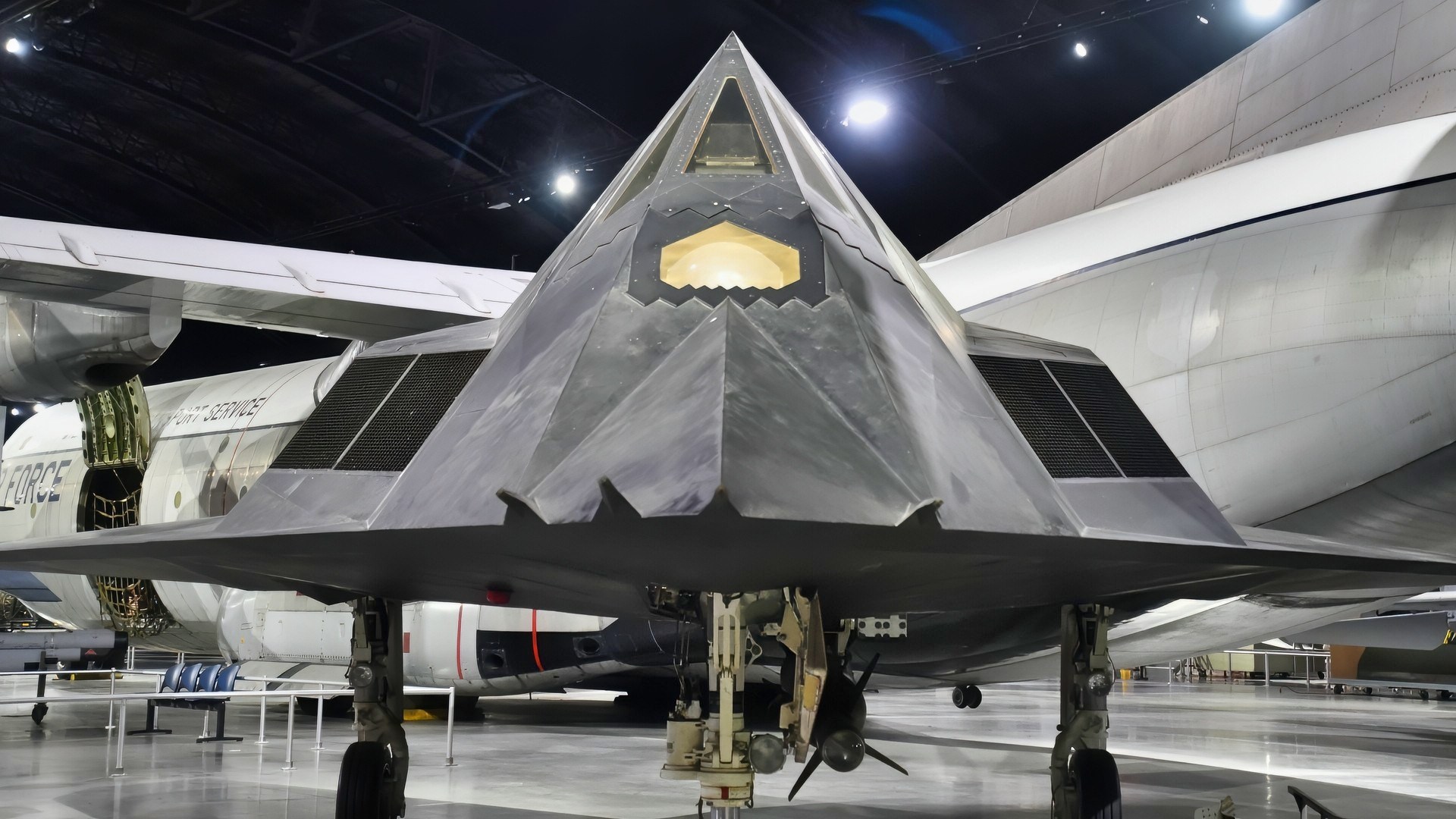Key Points and Summary – The F-117A Nighthawk was built for one job: slip past dense air defenses and put a smart bomb exactly where it counted.
-Born in secrecy in the early 1980s and revealed in 1988, it debuted over Panama, then became the face of precision strike in Desert Storm.
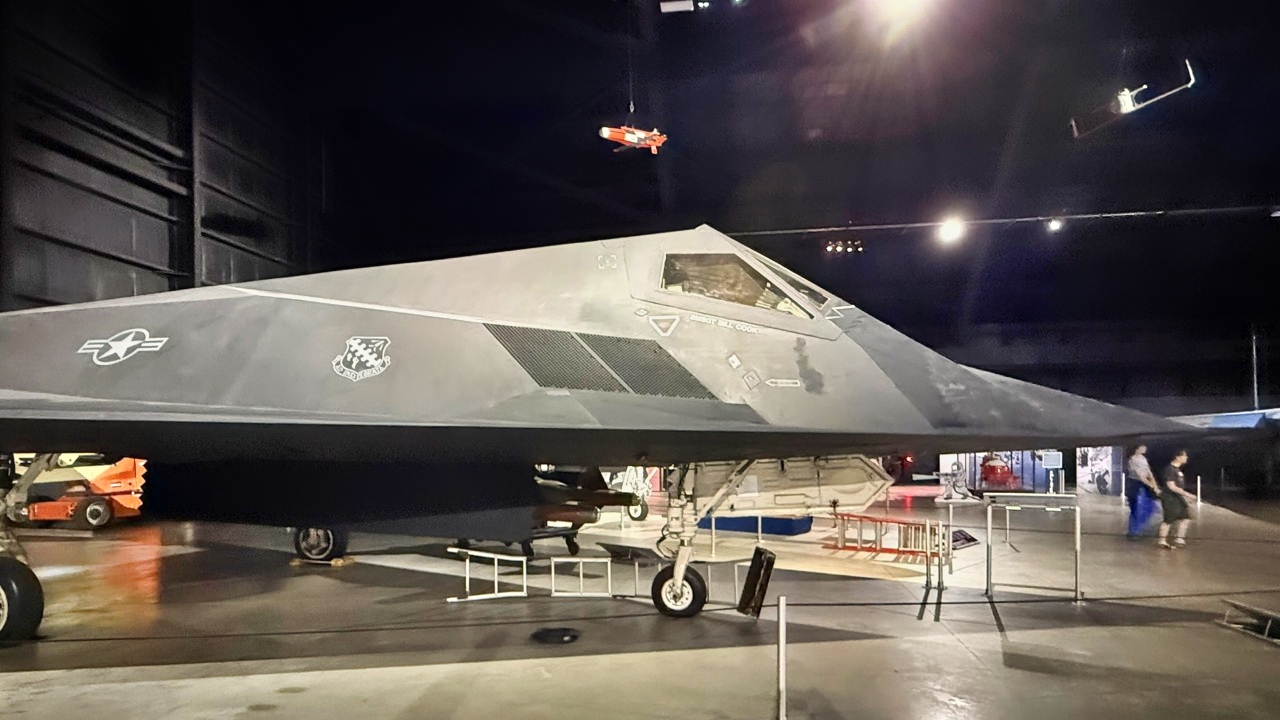
F-117 Stealth Fighter Original National Security Journal Photo.
-It absorbed hard lessons in Serbia, opened the 2003 Iraq war, and retired in 2008—only to keep flying for test and training roles.
-Its combat record proved that stealth and precision could break the back of modern air defenses, and its continuing second life is a reminder that the “black jet” still has lessons left to teach.
F-117A: Why The Jet Existed At All
There is no plane that I love more than the F-117A Nighthawk, or what I like to call the F-117 Stealth Fighter. Yes, I know that is the correct name, but the little boy in me who saw this in the 1990s air shows back in Rhode Island will always know it by that name.
I recently saw the plane at the U.S. Air Force Museum in Dayton, Ohio, back in June. I took so many pictures, many of which are included in this article, that my iPhone 16 ProMax nearly ran out of battery life. But enough about me…
By the late Cold War, U.S. planners had a problem: how do you hit a heavily defended target without losing aircraft and crews to dense Soviet-style air defenses? Radar-guided missiles, modern warning networks, and ever-better interceptors made classic “charge through flak” operations too costly. The answer wasn’t more speed or altitude; it was disappearance. Engineers at Lockheed’s Skunk Works combined faceted shaping, radar-absorbent materials, and a “night-only” concept of operations to create an airplane that looked wrong to the human eye—and nearly invisible to the most important sensors on the battlefield.
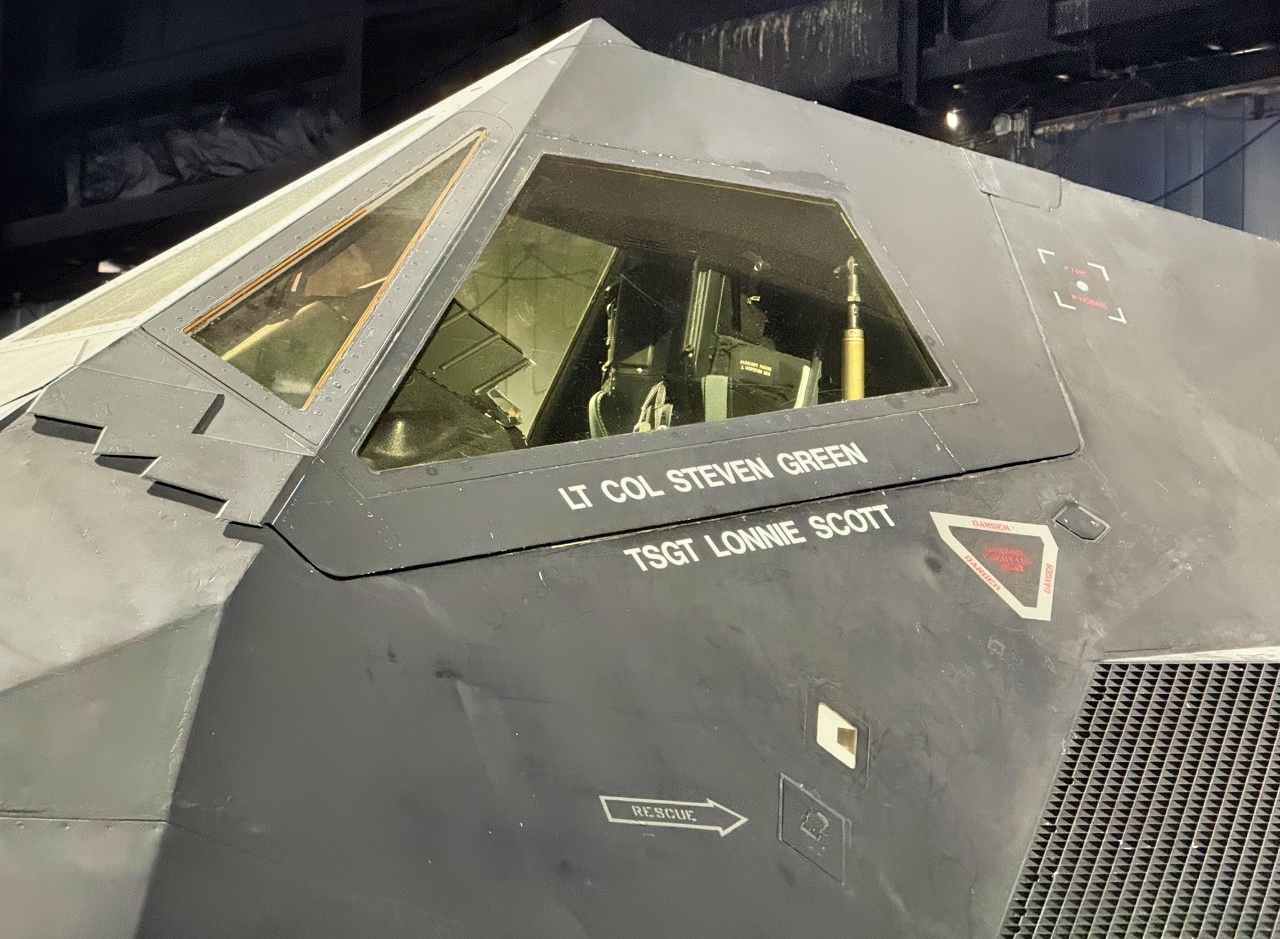
F-117 Up Close at USAF Museum. Image Credit: National Security Journal.
Stealth alone wouldn’t be enough, so the design centered on accuracy. The F-117 was really a precision attack aircraft with a “fighter” designation. It carried two laser-guided bombs tucked inside a bay to preserve its low radar signature. The tradeoffs were obvious—limited payload, modest speed—but every compromise served the mission of slipping into the most dangerous airspace to strike exactly the right aim point.
From Secret Program To “Black Jet”
The F-117A first flew in 1981 and quietly achieved initial combat capability in 1983. For years it lived in the shadows of the Nevada desert, flown at night and described only in rumor. When the Pentagon finally acknowledged the aircraft in late 1988, it turned out that aviation’s future looked like a dozen sharp-edged facets, matte black skin, and tiny saw-toothed openings. The Nighthawk was not a dogfighter; it was a scalpel designed to cut apart a modern air defense network with minimal risk to pilots and civilians.
Baptism Of Fire: Panama, 1989
The F-117’s first combat came during Operation Just Cause. The mission was ambitious—nighttime precision strikes intended to shock Panamanian forces near Rio Hato so U.S. paratroopers could land with an edge.
Results were mixed, and the operation produced immediate lessons about fusing stealth tactics with real-time targeting, weather, and joint maneuver on the ground. Still, the message was unmistakable: the United States now possessed a tool that could hit defended point targets at will, even at night, with minimal warning.
The Night Baghdad Went Dark: Desert Storm, 1991
In January 1991 the F-117A Nighthawk stepped onto the world stage. On the war’s opening night, F-117s slipped into the heart of Baghdad and cracked open a dense wall of radars, command bunkers, and hardened facilities.
They flew a small fraction of the war’s sorties but hit a remarkably high share of the most important strategic targets—without a single combat loss during the campaign. Two big truths emerged. First, stealth and precision together could dismantle a sophisticated integrated air defense system. Second, the value of near-surgical strikes—limiting collateral damage while achieving strategic effects—wasn’t theoretical anymore.
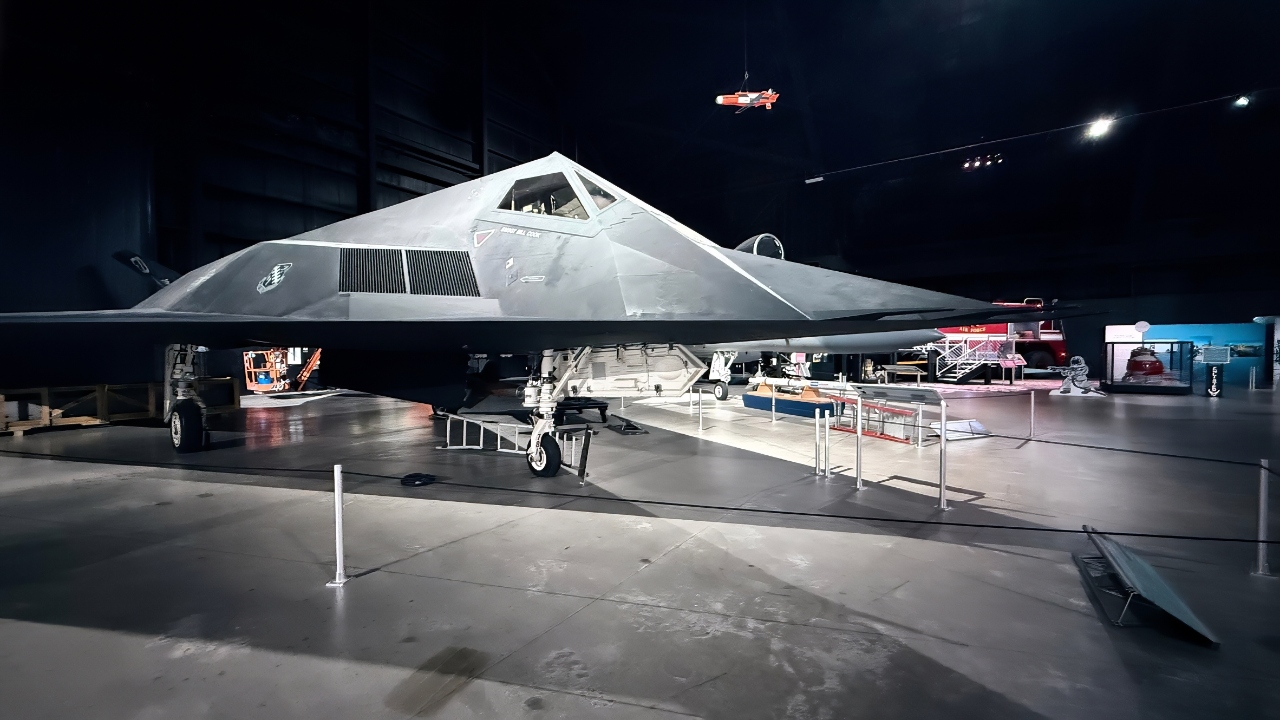
F-117 Still Looks Amazing National Security Journal Photo. All Rights Reserved.
Between Wars: Containment And Constant Pressure
The 1990s weren’t quiet for the Nighthawk. Enforcing no-fly zones over Iraq and deterring the regime’s air defenses demanded frequent deployments. In 1998, when the United States and the United Kingdom launched limited strikes to punish Baghdad’s refusal to cooperate with inspectors, the F-117 once again sat near the tip of the spear. These operations refined the aircraft’s rhythm: careful mission planning, laser-guided precision, and a deep reliance on joint intelligence and targeting teams that were learning to move faster every year.
Stealth Meets Adaptation: Serbia, 1999
Kosovo was a harsh teacher. Serbian air defenders, outgunned but clever, studied the Nighthawk’s routes and habits, exploited moments when bomb bay doors opened, and used well-concealed, older surface-to-air missiles to ambush one F-117 and damage another.
The pilot of the downed jet was rescued, but the image of broken stealth panels in a Belgrade museum put an end to the idea that low-observables were magic. The real lesson was subtler: stealth is an advantage, not a force field. Tactics must evolve. Flight paths must vary. Emissions and timing matter. The Nighthawk community absorbed those lessons quickly, and so did the rest of the Air Force.
One More Opening Night: Iraq, 2003
Four years later, the F-117A was again among the first aircraft over Baghdad. Opening-night strikes sought to decapitate leadership and blind command nodes. Newer precision-guided munitions improved flexibility against hardened facilities and dynamic targets.
Even as fourth-generation fighters and bombers filled the sky, the Nighthawk remained the go-to option for a handful of the most sensitive, high-leverage aim points—jobs where surprise and accuracy were worth more than mass tonnage.
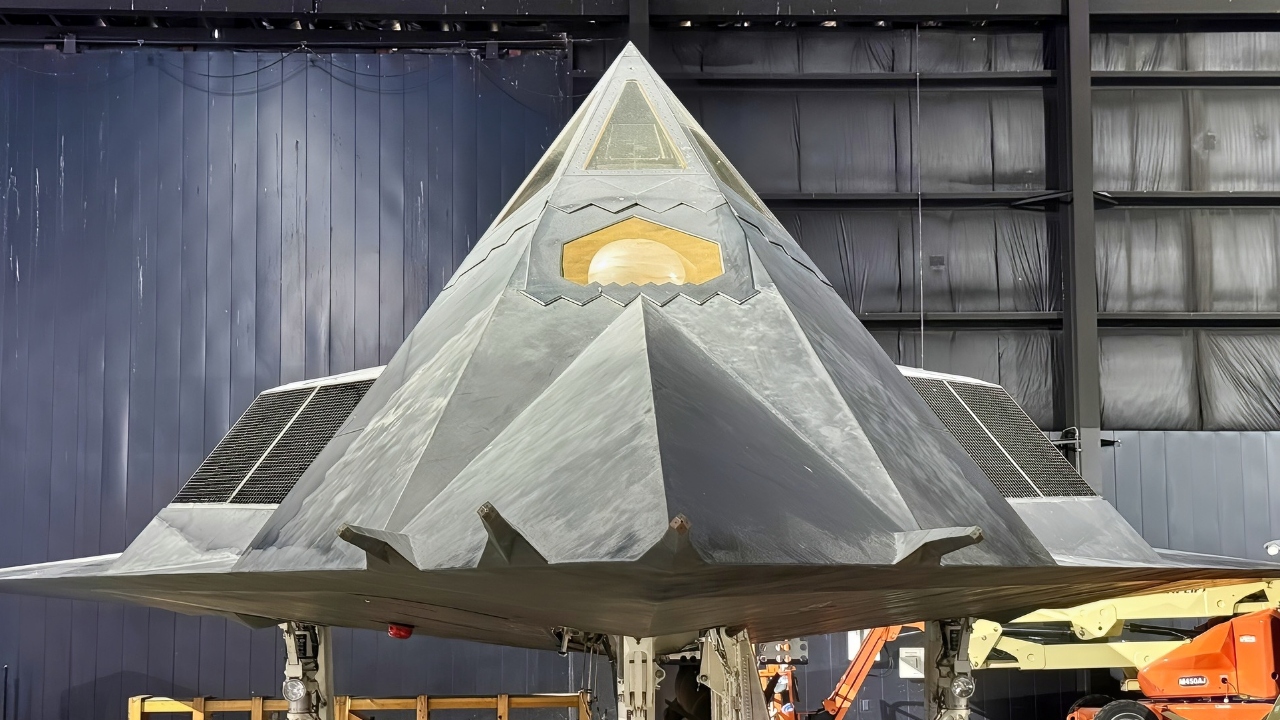
F-117 Nighthawk National Security Journal Photo July 2025
Why Retire An Airplane That Works?
By the mid-2000s, the F-117A Nighthawk had done its job so well that it helped usher in its own replacement. The B-2 bomber carried more weapons farther with similar stealth. The F-22 arrived with stealth, speed, sensors, and air-to-air dominance. Sustainment for an aging, hand-built, low-volume fleet was expensive. The airplane’s two-bomb payload and narrow mission didn’t fit a force gravitating toward multirole platforms with big sensor fusion. The Air Force announced retirement plans in 2006 and officially said goodbye in 2008 with a formation “sunset stealth” flyover at its longtime home at Holloman.
The Sunset That Never Went Fully Dark
And yet—those black triangles never disappeared. The jets went into “flyable storage,” a kind of mothball status that keeps airframes supportable and ready for special tasks. Over the last decade, sightings and photos confirmed what aviators long suspected: a small number of F-117s still fly.
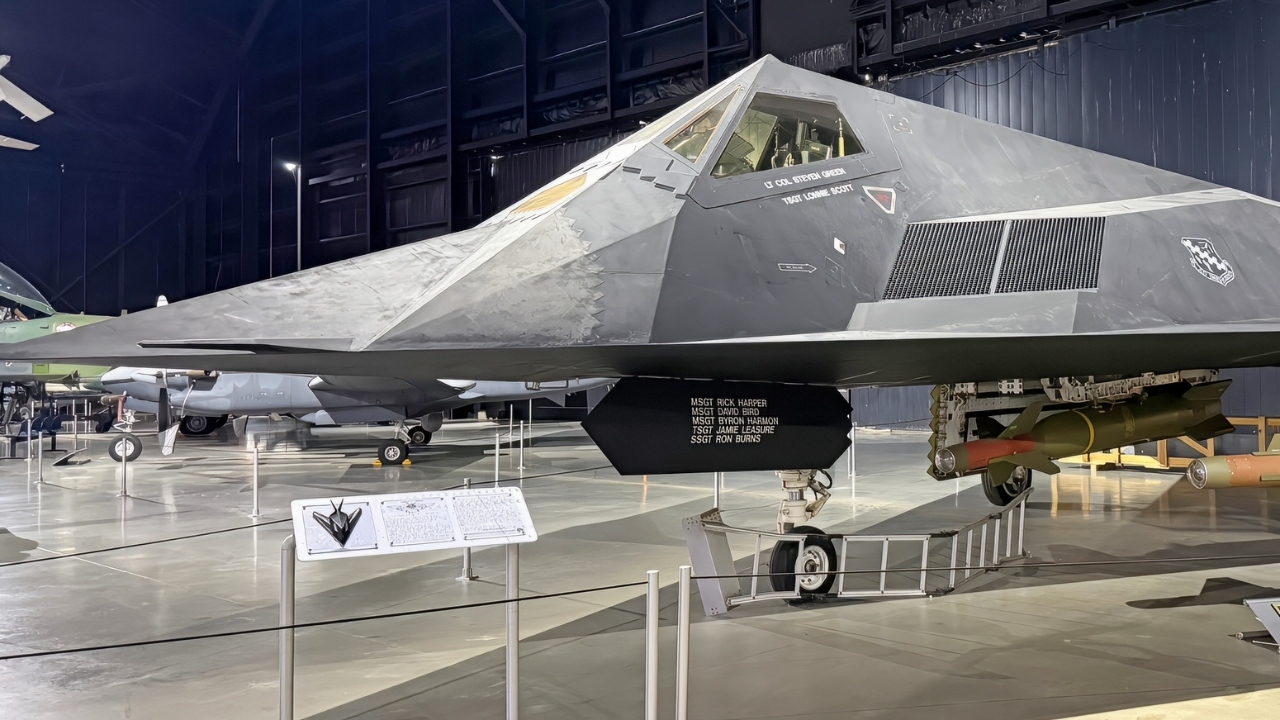
F-117 Stealth Fighter National Security Journal Image.
Official statements now acknowledge the aircraft support training and test roles, acting as stealthy aggressors to sharpen the skills of newer fighters and the air defenses that hunt them. Public contracting documents indicate the Air Force has looked at sustaining Nighthawk operations well into the 2030s. For a jet designed before most of today’s pilots were born, that is a remarkable second act.
What do those flights buy? Real, repeatable practice against a low-observable target—something you can’t fake on a computer screen. They provide a radar-signature sparring partner for F-15s, F-16s, and F-35s; they help evaluate sensors, tactics, and counter-stealth concepts; and they give testers a steady, known baseline for measuring how systems respond to a true stealth threat profile.
What The F-117 Changed About Airpower
Stealth as a System, Not a Sticker. The F-117A proved that low-observables work only when everything—shape, coatings, doors, antennas, weapons carriage—supports the signature goal. It also proved the operational piece: aircrews fly at night, from carefully prepared bases, with meticulous mission planning to minimize every stray reflection or infrared plume.
Precision as Strategy. The Nighthawk didn’t just hit targets; it allowed leaders to select targets they previously would have avoided because of collateral-damage risk or the cost of losing crews. Hitting the right 50 nodes can be more decisive than blitzing 500.
The Culture of Joint Targeting. The planning cells that fed F-117 strikes blended intelligence, engineers, weaponeers, and lawyers. Those “strike boards” became the model for later air campaigns where precision and legitimacy mattered as much as destruction.
A Different Kind of Risk. The jet was fragile if caught in the open. It had no radar, no missile warning receiver in early years, and no defensive missiles. The cockpit workload was high, and the airplane’s aerodynamics were controlled by computers that had to be trusted completely. But when used as designed, risk plummeted—especially compared to tossing large formations against overlapping missile belts.
Why It Still Matters In 2025
When you see a training photo of an F-117A today, you’re looking at an airplane that still fills a unique niche. New stealth jets like the F-35 and forthcoming B-21 are more capable, but there is value in an expendable, well-understood stealth target for red-on-blue practice and sensor development. The Nighthawk is perfect for that role: stealthy enough to be meaningful, simple enough to operate in small numbers, proven enough to trust as a baseline.
There’s also the human factor. The aircraft taught a generation of pilots how to plan, fly, and debrief missions where surprise is your only shield. That mindset—disciplined, methodical, humble about the limits of technology—has become the default approach to high-end air warfare.
The F-117 Nighthawk in 4 Words: She Will Stay Retired
It’s tempting to ask: if the F-117A still offers value, why retire it at all?
Because air forces live on tradeoffs. A bespoke, hand-built, single-mission fleet is expensive to keep combat-coded, and it competes for money and maintainers with multirole fleets that can do more things in more places.
The smarter approach was to harvest the Nighthawk’s lessons, transfer the core of its mission to platforms with broader utility, and keep a handful of airframes for specialized test and training. That is exactly what happened.
The Nighthawk’s Lasting Legacy
The F-117A taught the world that the combination of stealth, precision, and disciplined tactics could break open the most defended airspace on Earth. It made opening-night strikes both more effective and more humane. It forced adversaries to rethink how they build and use their air defenses. It changed how we train, how we plan, and how we talk about risk.
And even now, long after its “retirement,” the black jet keeps writing footnotes in the margins of modern airpower—quietly, at night, exactly as intended.
About the Author: Harry J. Kazianis
Harry J. Kazianis (@Grecianformula) is Editor-In-Chief and President of National Security Journal. He was the former Senior Director of National Security Affairs at the Center for the National Interest (CFTNI), a foreign policy think tank founded by Richard Nixon based in Washington, DC. Harry has over a decade of experience in think tanks and national security publishing. His ideas have been published in the NY Times, The Washington Post, The Wall Street Journal, CNN, and many other outlets worldwide. He has held positions at CSIS, the Heritage Foundation, the University of Nottingham, and several other institutions related to national security research and studies. He is the former Executive Editor of the National Interest and the Diplomat. He holds a Master’s degree focusing on international affairs from Harvard University.
More Military
The U.S. Air Force’s B-52 Bomber and F-35 Fighter Have A Message for Venezuela
Russia’s Mach 4.3 MiG-41 Stealth Fighter Has a Message for the U.S. Air Force
Forget the F-35: The MQ-25 Stingray Might Be the Navy’s Best ‘Weapon’ Against China
Forget the F-35 of F-47: The GCAP 6th Generation Stealth Fighter Is Coming
U.S. and 9 Allies Just Held a Big Naval Exercise Right on China’s Doorstep


